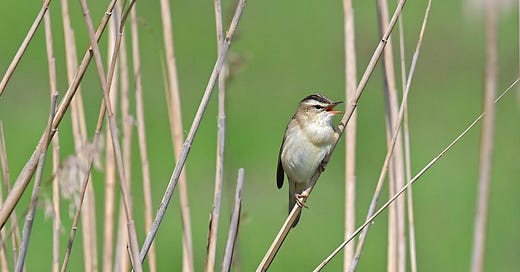If there was a prize for angriest sounding bird of Britain, sedge warblers would be in with a shout. And that shout would be quite irritable.
A summer visitor to wetlands up and down the UK, sedge warblers deliver a wide range of buzzes, chirrups and whistles at frenetic speed.
The song is very similar to that of reed warbler, with which sedge warblers often live in close proximity. Not helpful.
However, sedge warblers can’t maintain a steady pace to their song, chopping and changing the rhythm, and throwing in one-off sounds (especially that whistle). You might imagine a mechanical bird receiving too much power and malfunctioning.
Unlike reed warblers, sedge warblers have a song-flight, fluttering a little way above the bramble, hawthorn or patch of reeds that they’ll parachute back into as the song subsides.
And being curious beasts, they will often come close to check out a human observer. The birds jump and climb expertly through the vegetation, and with a little luck poke out their distinctively stripy head.
Sedge warblers are much more widely distributed than reed warblers, occurring throughout the island of Ireland and into northern Scotland. They continue to make angry noises through the summer, before disappearing in August and early September.
More help separating reed and sedge warblers from the BTO:
Media credits:
Recording by Bob Ashington
Image by Georg_Wietschorke
Now booking with Birdsong Academy
British Birdsong Essentials begins again in February 2022.
Half-day Sussex walking workshops are running in September (Hastings Country Park) and November (Pevensey Levels).



